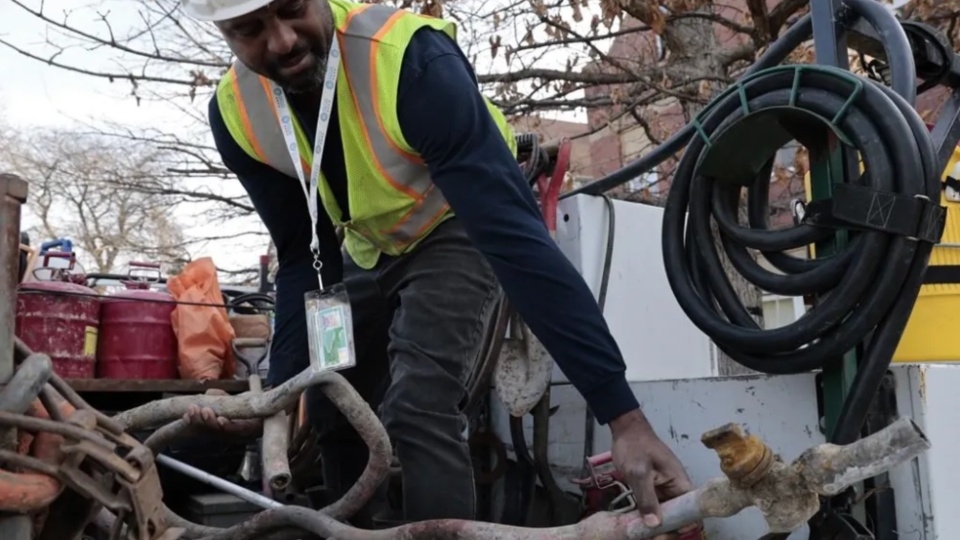
WASHINGTON—To cheers from building trades unions and the BlueGreen Alliance, the Biden administration’s Environmental Protection Agency unveiled a ten-year, multi-billion-dollar plan to eliminate and replace all leaded water pipes nationwide.
Speaking in Milwaukee, the largest city in swing state Wisconsin, Democratic President Joe Biden said the EPA will allot at least $2.6 billion for drinking water upgrades and lead pipe replacements, on top of $15 billion or more in dedicated Infrastructure and Jobs Act money for lead pipe replacement. Up to $11 billion more could come from federal cash sent to state infrastructure revolving funds.
The goal of the new funding is to eliminate all lead from all drinking water pipes, whether they’re main underground lines, water lines in schools, feeder lines to homes, or even lines to drinking fountains.
But while Biden unveiled the plan in Milwaukee, the nation’s biggest lead contamination in water is in Chicago, National Public Radio reported earlier this year. One expert said virtually every child under the age of 6 in the city is drinking water from leaded pipes.
“Lead in drinking water irreparably harms the health of children and adults and disproportionately impacts lower-income communities and communities of color,” EPA said in unveiling the new rule. “Legacy lead pipes, which have delivered drinking water to homes for decades, have exposed generations of Americans to toxic lead and will continue to do so until they are removed.”
As promised by the infrastructure law, union workers will be employed on removing the lead from the water pipes. That drew praise from the United Association of Plumbers and Pipefitters, whose present and future members will do the work, from the BlueGreen Alliance of unions and environmental groups, and from North America’s Building Trades.
“The Biden administration continues to prioritize our families and communities,” NABTU President Sean McGarvey said after EPA’s October announcement. “This final rule by the Environmental Protection Agency to identify and replace lead pipes across this country will not only provide cleaner drinking water to millions of Americans, but it will do so while creating local middle-class sustaining union jobs.”
“You’re going to hear about all this federal investment,” he elaborated in March during a building trades investment tour, the Building Tradesman of Detroit reported. “We see it at the moment to provide an opportunity to the next generation of skilled trades professionals, what we like to call now the infrastructure generation.”
BlueGreen Alliance’s Regional Field Manager for Water Infrastructure Richard Diaz, who was at Biden’s announcement, thanked the president and Vice President Kamala Harris, the Democratic presidential nominee, “for their leadership in removing these lead pipes poisoning our water.
“This issue hits close to home for families around Wisconsin—particularly for families of color. The administration has put the right policies and investments in place to help make sure that everyone in Wisconsin and across the country will have access to safe, clean water in their homes.”
The problem of lead in the nation’s water pipes sprang to the nation’s attention a decade ago when complaints from Flint, Mich., residents after foul-smelling, foul-tasting drinking water led to an investigation by pediatrics professor Dr. Mona Hanna-Attisha. She blew the whistle on the danger.
The lead entered Flint’s water system when a Republican-appointed financial “czar” for the majority-minority city decided to save money by switching Flint’s water source from clean Lake Huron to the polluted Detroit River.
The chemicals in the river corroded Flint’s pipes, releasing the lead into the city’s drinking water. Residents had to bathe, drink, and wash their hands in bottled water for years.
Flint’s pipes are now all new and free of lead. But a National Public Radio program on the tenth anniversary of the Flint water disaster, featuring Dr. Hanna-Attisha, showed Chicago’s aren’t. “Most children under the age of 6 in Chicago are probably drinking leaded water,” she said.
“Chicago has a long history of lead advocates, but also a long history of lead misuse. Chicago continued to use lead in their service lines until it was restricted in 1986 and built into the code. If you wanted water from the main, you were mandated to use lead in your plumbing. So Chicago has the most lead lines than any other city in our nation.
“And, you know, if you respect the science of lead, if you understand it has no safe level, lead should not be the straw that is delivering our drinking water to so many children and families.
“We need water to survive. It’s a medical and public health necessity. And the younger you are, the more our bodies are made up of water.”
We hope you appreciated this article. At People’s World, we believe news and information should be free and accessible to all, but we need your help. Our journalism is free of corporate influence and paywalls because we are totally reader-supported. Only you, our readers and supporters, make this possible. If you enjoy reading People’s World and the stories we bring you, please support our work by donating or becoming a monthly sustainer today. Thank you!










